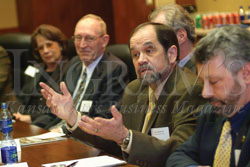 Ron Trewyn of Kansas State discusses the virtues of collaboration among the land grant institutions in Kansas and Missouri. Jim Coleman of MU (right), Gerald Loper of Wichita State and Joan Hunt of University of Kansas Medical Center observe.
Ron Trewyn of Kansas State discusses the virtues of collaboration among the land grant institutions in Kansas and Missouri. Jim Coleman of MU (right), Gerald Loper of Wichita State and Joan Hunt of University of Kansas Medical Center observe. Jim Spigarelli, chairman of the KCALSI board, commented that KCALSI specifically asked its consultants to expand the field of vision to Columbia and Manhattan for the hot teams.
Jim Coleman of MU noted that Kansas City has yet to take complete advantage of the assets that are already here. Adding KSU and MU to the regional mix would mean an extra $300 million in research dollars right there. “We want to help,” he added. Ron Trewyn of KSU affirmed Coleman’s point, arguing for a Columbia to Manhattan to Wichita axis. This expanded scope makes sense especially in the area of animal health since both KSU and MU have strong veterinary programs.
“It’s all about people,” Duncan noted. He cited specifically the need to recruit a key person or two to inspire growth in a given area with the understanding that facilities and equipment would follow.
Homeland Security
An area of keen interest over the last several years has been national security-related research. Spigarelli asked his colleagues what kind of success they have had with bio-terrorism budgets.
All agreed that the Department of Homeland Security (DHS) has not been the easiest agency with which to work. Ron Trewyn of KSU told of making a joint application with MU to the DHS. They were sure “they had done a great job” only to come away empty-handed. “In the process,” said Trewyn, “I will never be convinced that [the turn down] was anything other than political.” He wondered whether universities have a real place in the Homeland Security planning process, which he called “still a work in progress.”
Jim Roberts noted that KU has been making a number of security-related applications, but not with DHS. As Roberts added, KU also has “some internal issues” to work through, specifically a Vietnam-era prohibition on classified research.
Although 50 percent of MRI’s work is currently in the area of bio-defense, “not a penny” comes directly from DHS. Mike Helmstetter argued that this was “not from a lack of trying.” From his perspective, DHS seemed to be funding the kind of high-risk ventures with which MRI has not historically been comfortable.
In conjunction with Washington University, MU houses one of the original nine centers funded by DHS, but that is something of a mixed blessing. As Jim Coleman and others commented, universities are not sure how much they want to invest in what might be a short-term project. Said Coleman in something of an understatement, “Homeland Security is an agency that’s very difficult to understand.”
Barriers
Jim Spigarelli raised the day’s most sensitive question: which barriers prevent the two states in question from developing their full bioscience potential?
“Resources and politics,” said Ron Trewyn, summing the issue up in two words, the latter being trickier than the former. Although no one thought this assembly to be the right venue to debate the particulars of stem cell research or even evolution, the ramifications of both debates, the former in Missouri, the latter in Kansas, could not be avoided.
As Joan Hunt observed, it was necessary for participants “to help develop appropriate but not radical strategies” in relation to sensitive issues. “Many of our problems can be solved with appropriate information,” she added. “Scientists have not done a very good job of educating.”
Although Kansas has drawn more attention because of the public debates over the proper role of evolutionary theory in public schools, pending stem cell legislation in Missouri was of more immediate concern.
As Bill Duncan noted, “the incredible Stowers’ investment” has been instrumental in getting the life sciences initiative off the ground. According to Duncan, however, “Stowers can’t pull the trigger on the second phase of investment if [the stem cell] legislation passes.”
“It’s about more than just stem cells,” added Jim Coleman. “It’s about the role of science in peoples’ lives. That’s part of the reality.”
This debate runs the risk of pitting the science community against a large body of citizens, a state of affairs that no one welcomes. Bill Duncan recommends that the scientists should provide all the information they can. “Then people have to call in their own values and make their own decisions.”
Jim Coleman suggested that the business community be enlisted in the debate since it always seems “self-serving” when universities argue their own case. Jim Roberts suggested tapping the alumni to help in the educational process.
“Even if self-serving,” Betty Drees countered, “universities have a responsibility to provide as much information as they can.” She also noted the participants were “fortunate” to have the Center for Practical Bioethics located in KC. The 20-year-old Center’s mission is to create “a morally safe place in which to raise and respond to complex ethical issues affecting our families’ and our nation’s health and healthcare.” The embryonic stem cell debate would seem to fall nicely within its jurisdiction.